warning SKODA YETI 2013 1.G / 5L Repair Manual
[x] Cancel search | Manufacturer: SKODA, Model Year: 2013, Model line: YETI, Model: SKODA YETI 2013 1.G / 5LPages: 266, PDF Size: 26.71 MB
Page 84 of 266
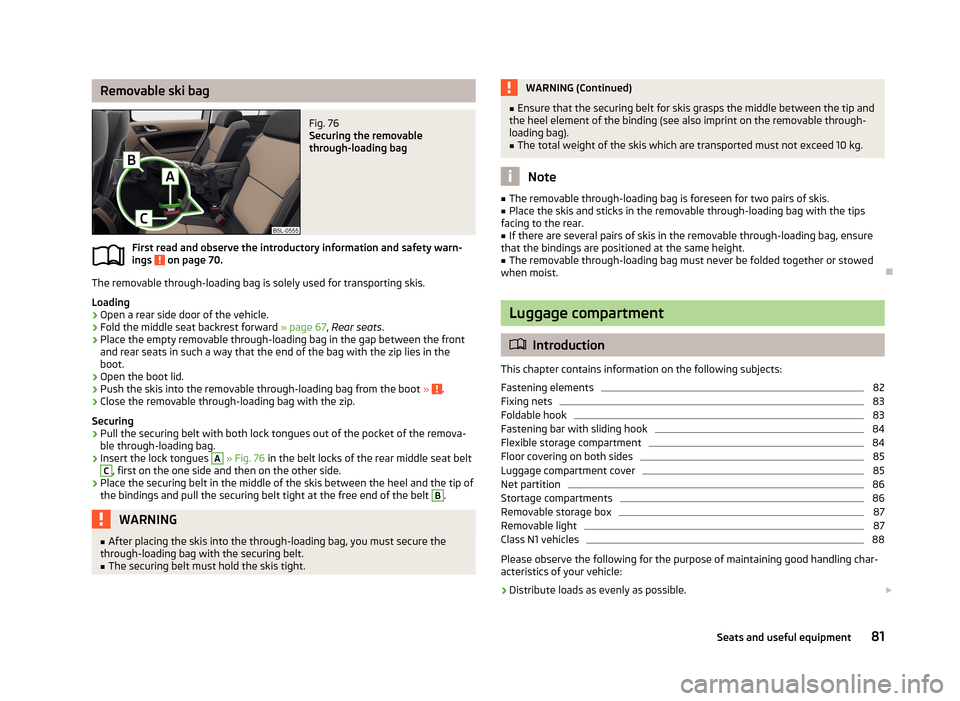
Removable ski bagFig. 76
Securing the removable
through-loading bag
First read and observe the introductory information and safety warn-
ings on page 70.
The removable through-loading bag is solely used for transporting skis.
Loading
›
Open a rear side door of the vehicle.
›
Fold the middle seat backrest forward » page 67, Rear seats .
›
Place the empty removable through-loading bag in the gap between the front
and rear seats in such a way that the end of the bag with the zip lies in the
boot.
›
Open the boot lid.
›
Push the skis into the removable through-loading bag from the boot » .
›
Close the removable through-loading bag with the zip.
Securing
›
Pull the securing belt with both lock tongues out of the pocket of the remova- ble through-loading bag.
›
Insert the lock tongues
A
» Fig. 76 in the belt locks of the rear middle seat belt
C
, first on the one side and then on the other side.
›
Place the securing belt in the middle of the skis between the heel and the tip of
the bindings and pull the securing belt tight at the free end of the belt
B
.
WARNING■ After placing the skis into the through-loading bag, you must secure the
through-loading bag with the securing belt.■
The securing belt must hold the skis tight.WARNING (Continued)■ Ensure that the securing belt for skis grasps the middle between the tip and
the heel element of the binding (see also imprint on the removable through-
loading bag).■
The total weight of the skis which are transported must not exceed 10 kg.
Note
■ The removable through-loading bag is foreseen for two pairs of skis.■Place the skis and sticks in the removable through-loading bag with the tips
facing to the rear.■
If there are several pairs of skis in the removable through-loading bag, ensure
that the bindings are positioned at the same height.
■
The removable through-loading bag must never be folded together or stowed
when moist.
Luggage compartment
Introduction
This chapter contains information on the following subjects:
Fastening elements
82
Fixing nets
83
Foldable hook
83
Fastening bar with sliding hook
84
Flexible storage compartment
84
Floor covering on both sides
85
Luggage compartment cover
85
Net partition
86
Stortage compartments
86
Removable storage box
87
Removable light
87
Class N1 vehicles
88
Please observe the following for the purpose of maintaining good handling char-
acteristics of your vehicle:
›
Distribute loads as evenly as possible.
81Seats and useful equipment
Page 85 of 266
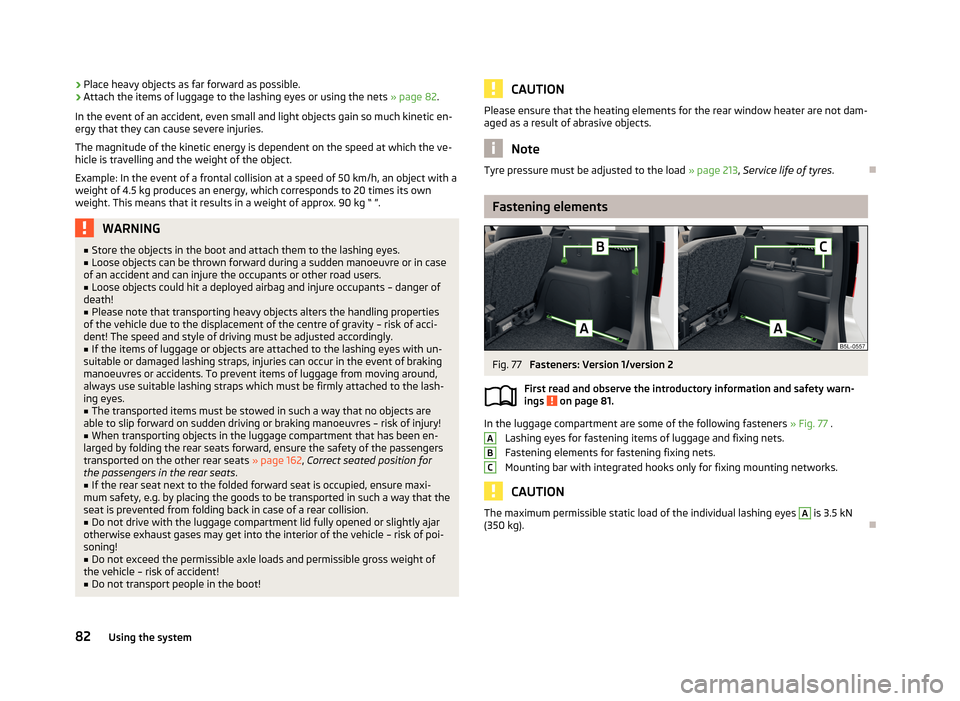
›Place heavy objects as far forward as possible.›Attach the items of luggage to the lashing eyes or using the nets
» page 82.
In the event of an accident, even small and light objects gain so much kinetic en-
ergy that they can cause severe injuries.
The magnitude of the kinetic energy is dependent on the speed at which the ve-
hicle is travelling and the weight of the object.
Example: In the event of a frontal collision at a speed of 50 km/h, an object with a
weight of 4.5 kg produces an energy, which corresponds to 20 times its own
weight. This means that it results in a weight of approx. 90 kg “ ”.WARNING■ Store the objects in the boot and attach them to the lashing eyes.■Loose objects can be thrown forward during a sudden manoeuvre or in case
of an accident and can injure the occupants or other road users.■
Loose objects could hit a deployed airbag and injure occupants – danger of
death!
■
Please note that transporting heavy objects alters the handling properties
of the vehicle due to the displacement of the centre of gravity – risk of acci-
dent! The speed and style of driving must be adjusted accordingly.
■
If the items of luggage or objects are attached to the lashing eyes with un-
suitable or damaged lashing straps, injuries can occur in the event of braking manoeuvres or accidents. To prevent items of luggage from moving around,
always use suitable lashing straps which must be firmly attached to the lash-
ing eyes.
■
The transported items must be stowed in such a way that no objects are
able to slip forward on sudden driving or braking manoeuvres – risk of injury!
■
When transporting objects in the luggage compartment that has been en-
larged by folding the rear seats forward, ensure the safety of the passengers transported on the other rear seats » page 162, Correct seated position for
the passengers in the rear seats .
■
If the rear seat next to the folded forward seat is occupied, ensure maxi-
mum safety, e.g. by placing the goods to be transported in such a way that the
seat is prevented from folding back in case of a rear collision.
■
Do not drive with the luggage compartment lid fully opened or slightly ajar
otherwise exhaust gases may get into the interior of the vehicle – risk of poi-
soning!
■
Do not exceed the permissible axle loads and permissible gross weight of
the vehicle – risk of accident!
■
Do not transport people in the boot!
CAUTIONPlease ensure that the heating elements for the rear window heater are not dam-
aged as a result of abrasive objects.
Note
Tyre pressure must be adjusted to the load » page 213, Service life of tyres .
Fastening elements
Fig. 77
Fasteners: Version 1/version 2
First read and observe the introductory information and safety warn- ings
on page 81.
In the luggage compartment are some of the following fasteners » Fig. 77 .
Lashing eyes for fastening items of luggage and fixing nets.
Fastening elements for fastening fixing nets.
Mounting bar with integrated hooks only for fixing mounting networks.
CAUTION
The maximum permissible static load of the individual lashing eyes A is 3.5 kN
(350 kg).
ABC82Using the system
Page 86 of 266
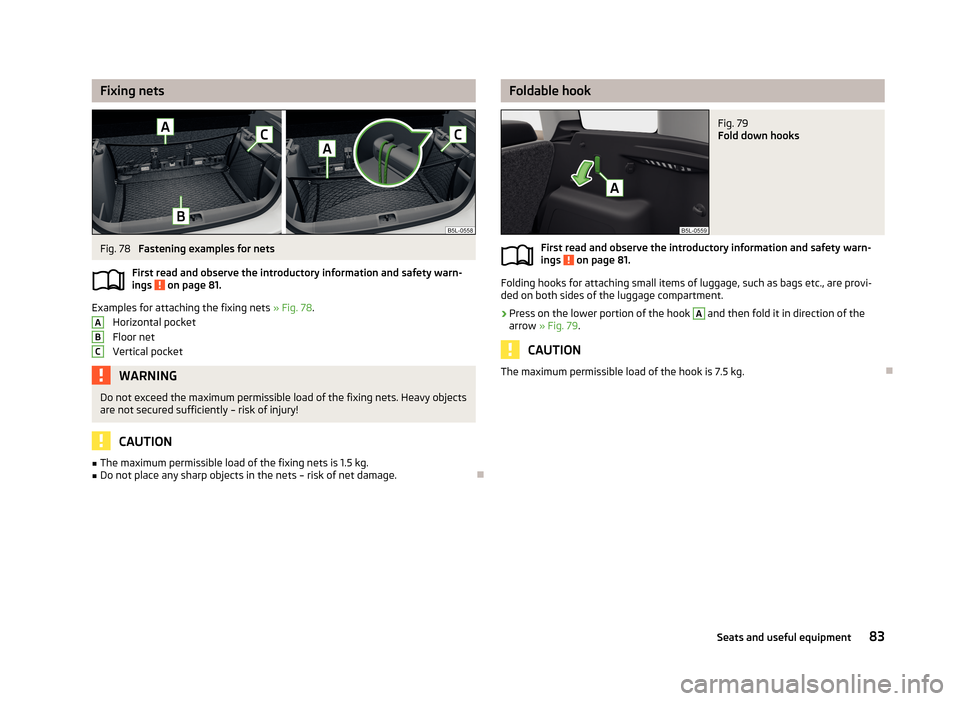
Fixing netsFig. 78
Fastening examples for nets
First read and observe the introductory information and safety warn-
ings
on page 81.
Examples for attaching the fixing nets » Fig. 78.
Horizontal pocket
Floor net
Vertical pocket
WARNINGDo not exceed the maximum permissible load of the fixing nets. Heavy objects are not secured sufficiently – risk of injury!
CAUTION
■ The maximum permissible load of the fixing nets is 1.5 kg.■Do not place any sharp objects in the nets – risk of net damage.
ABCFoldable hookFig. 79
Fold down hooks
First read and observe the introductory information and safety warn-
ings on page 81.
Folding hooks for attaching small items of luggage, such as bags etc., are provi-
ded on both sides of the luggage compartment.
›
Press on the lower portion of the hook
A
and then fold it in direction of the
arrow » Fig. 79 .
CAUTION
The maximum permissible load of the hook is 7.5 kg.
83Seats and useful equipment
Page 88 of 266
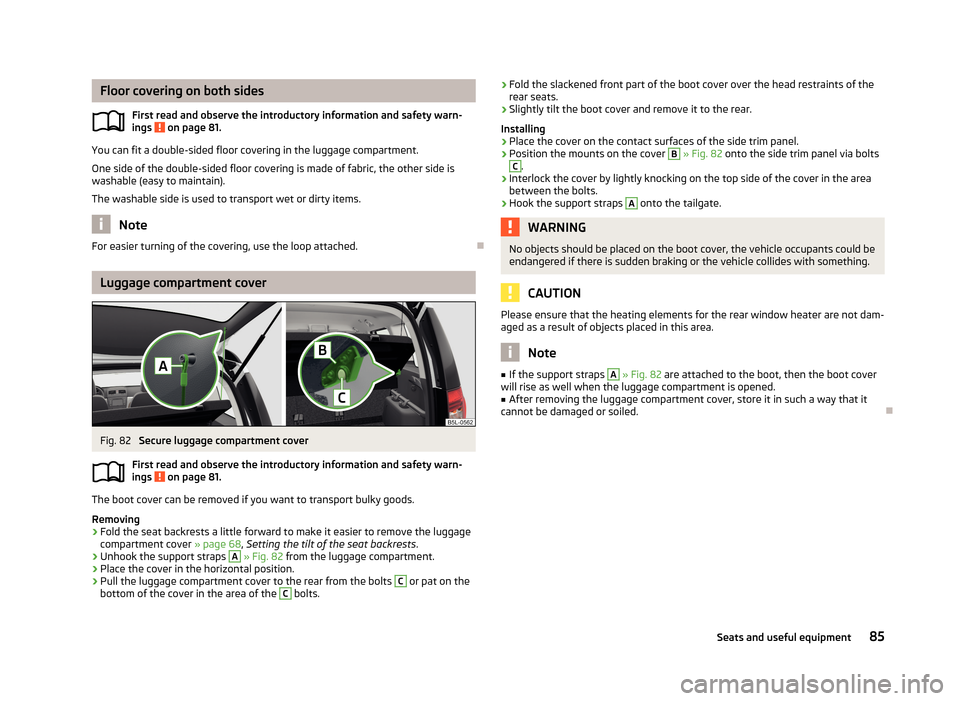
Floor covering on both sidesFirst read and observe the introductory information and safety warn-
ings
on page 81.
You can fit a double-sided floor covering in the luggage compartment.
One side of the double-sided floor covering is made of fabric, the other side is
washable (easy to maintain).
The washable side is used to transport wet or dirty items.
Note
For easier turning of the covering, use the loop attached.
Luggage compartment cover
Fig. 82
Secure luggage compartment cover
First read and observe the introductory information and safety warn- ings
on page 81.
The boot cover can be removed if you want to transport bulky goods.
Removing
›
Fold the seat backrests a little forward to make it easier to remove the luggage
compartment cover » page 68, Setting the tilt of the seat backrests .
›
Unhook the support straps
A
» Fig. 82 from the luggage compartment.
›
Place the cover in the horizontal position.
›
Pull the luggage compartment cover to the rear from the bolts
C
or pat on the
bottom of the cover in the area of the
C
bolts.
› Fold the slackened front part of the boot cover over the head restraints of the
rear seats.›
Slightly tilt the boot cover and remove it to the rear.
Installing
›
Place the cover on the contact surfaces of the side trim panel.
›
Position the mounts on the cover
B
» Fig. 82 onto the side trim panel via bolts
C
.
›
Interlock the cover by lightly knocking on the top side of the cover in the area
between the bolts.
›
Hook the support straps
A
onto the tailgate.
WARNINGNo objects should be placed on the boot cover, the vehicle occupants could be
endangered if there is sudden braking or the vehicle collides with something.
CAUTION
Please ensure that the heating elements for the rear window heater are not dam-
aged as a result of objects placed in this area.
Note
■ If the support straps A » Fig. 82 are attached to the boot, then the boot cover
will rise as well when the luggage compartment is opened.■
After removing the luggage compartment cover, store it in such a way that it
cannot be damaged or soiled.
85Seats and useful equipment
Page 90 of 266
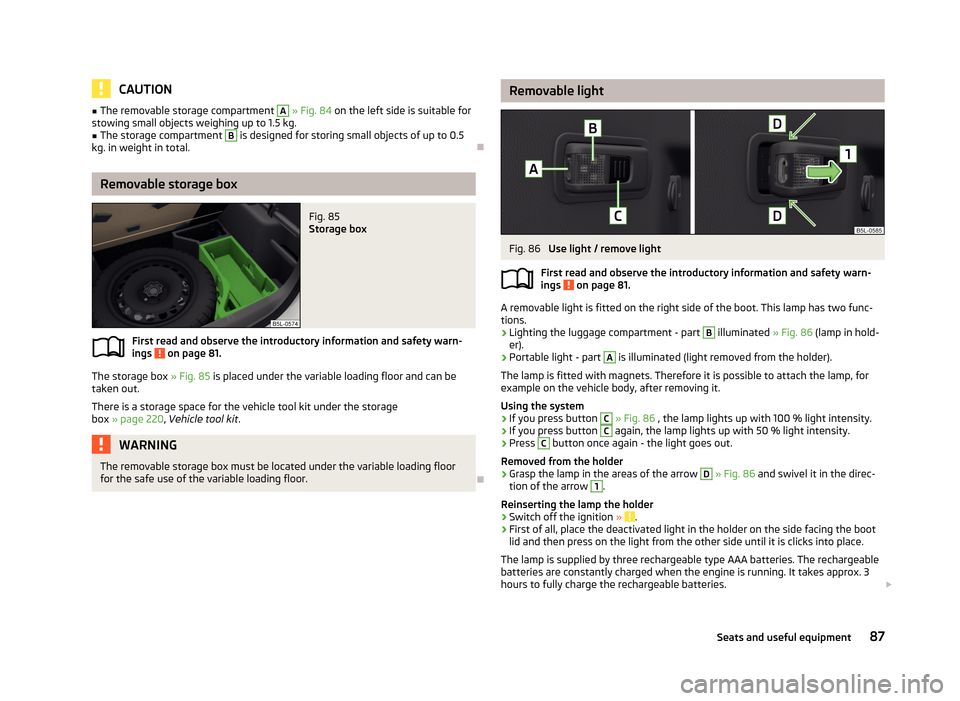
CAUTION■The removable storage compartment A » Fig. 84 on the left side is suitable for
stowing small objects weighing up to 1.5 kg.■
The storage compartment
B
is designed for storing small objects of up to 0.5
kg. in weight in total.
Removable storage box
Fig. 85
Storage box
First read and observe the introductory information and safety warn-
ings on page 81.
The storage box » Fig. 85 is placed under the variable loading floor and can be
taken out.
There is a storage space for the vehicle tool kit under the storage box » page 220 , Vehicle tool kit .
WARNINGThe removable storage box must be located under the variable loading floor
for the safe use of the variable loading floor.
Removable lightFig. 86
Use light / remove light
First read and observe the introductory information and safety warn-
ings
on page 81.
A removable light is fitted on the right side of the boot. This lamp has two func-
tions.
› Lighting the luggage compartment - part
B
illuminated
» Fig. 86 (lamp in hold-
er).
› Portable light - part
A
is illuminated (light removed from the holder).
The lamp is fitted with magnets. Therefore it is possible to attach the lamp, for
example on the vehicle body, after removing it.
Using the system
› If you press button
C
» Fig. 86 , the lamp lights up with 100 % light intensity.
› If you press button
C
again, the lamp lights up with 50 % light intensity.
› Press
C
button once again - the light goes out.
Removed from the holder
› Grasp the lamp in the areas of the arrow
D
» Fig. 86 and swivel it in the direc-
tion of the arrow
1
.
Reinserting the lamp the holder › Switch off the ignition
»
.
› First of all, place the deactivated light in the holder on the side facing the boot
lid and then press on the light from the other side until it is clicks into place.
The lamp is supplied by three rechargeable type AAA batteries. The rechargeable
batteries are constantly charged when the engine is running. It takes approx. 3
hours to fully charge the rechargeable batteries.
87Seats and useful equipment
Page 92 of 266
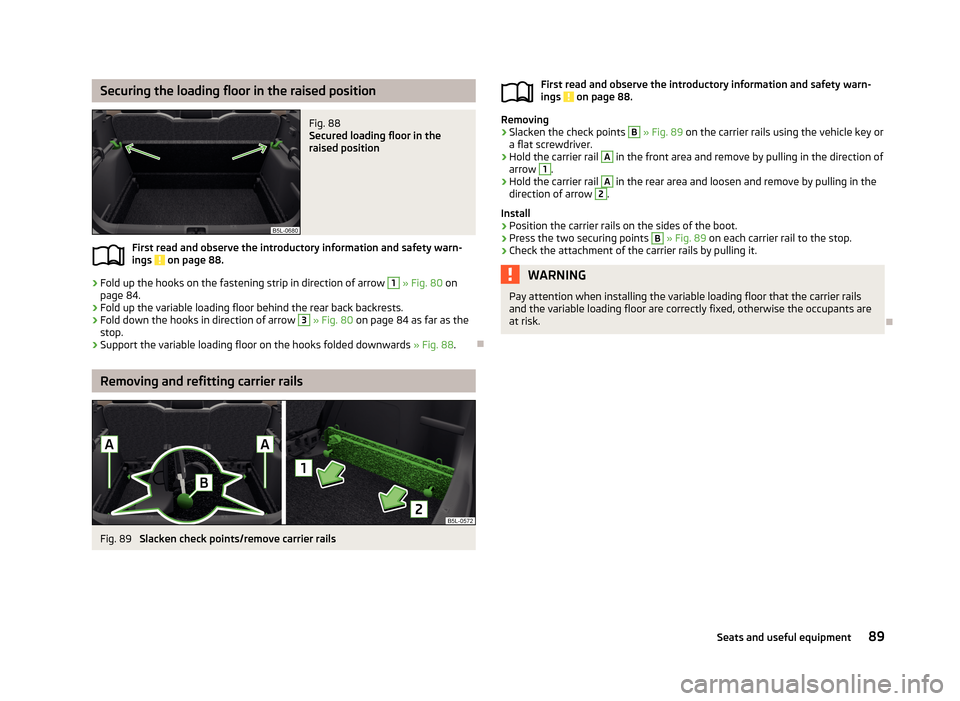
Securing the loading floor in the raised positionFig. 88
Secured loading floor in the
raised position
First read and observe the introductory information and safety warn-
ings on page 88.
›
Fold up the hooks on the fastening strip in direction of arrow
1
» Fig. 80 on
page 84.
›
Fold up the variable loading floor behind the rear back backrests.
›
Fold down the hooks in direction of arrow
3
» Fig. 80 on page 84 as far as the
stop.
›
Support the variable loading floor on the hooks folded downwards » Fig. 88.
Removing and refitting carrier rails
Fig. 89
Slacken check points/remove carrier rails
First read and observe the introductory information and safety warn-
ings on page 88.
Removing
›
Slacken the check points
B
» Fig. 89 on the carrier rails using the vehicle key or
a flat screwdriver.
›
Hold the carrier rail
A
in the front area and remove by pulling in the direction of
arrow
1
.
›
Hold the carrier rail
A
in the rear area and loosen and remove by pulling in the
direction of arrow
2
.
Install
›
Position the carrier rails on the sides of the boot.
›
Press the two securing points
B
» Fig. 89 on each carrier rail to the stop.
›
Check the attachment of the carrier rails by pulling it.
WARNINGPay attention when installing the variable loading floor that the carrier rails
and the variable loading floor are correctly fixed, otherwise the occupants are
at risk.
89Seats and useful equipment
Page 93 of 266

Using the variable loading floor with a spare wheelFig. 90
Fold up the side panels of the variable loading floor / space under
the variable loading floor
First read and observe the introductory information and safety warn-ings
on page 88.
The sides of the variable loading floor can be folded in the direction of ar-row » Fig. 90 -
.
The room under the variable loading floor » Fig. 90
can be used to stow ob-
jects.
Note
If the variable loading floor with spare wheel is installed, no flexible storage com-
partment can be installed.
Roof rack system
Introduction
This chapter contains information on the following subjects:
Roof load
90WARNING■ The transported items on the roof rack must be securely attached – risk of
accident!■
Always secure the load with appropriate and undamaged lashing straps or
tensioning straps.
■
Distribute the load evenly over the roof rack system.
■
When transporting heavy objects or objects which take up a large area on
the roof rack system, the handling of the car may change as a result of the displacement of the centre of gravity. The style of driving and speed musttherefore be adapted to the current circumstances.
■
Avoid abrupt and sudden driving/braking manoeuvres.
■
Adjust the speed and driving style to the visibility, weather, road and traffic
conditions.
■
The permissible roof load, permissible axle loads and permissible total vehi-
cle weight must not be exceeded under any circumstances – risk of accident!
CAUTION
■ Only roof racks from the ŠKODA Original Accessories range should be used.■When dealing with roof rack systems, the installation instructions supplied with
the roof luggage rack system must be observed.■
On vehicles with a panoramic sunroof, make sure that the tilted panorama roof
does not strike any items which are transported.
■
Ensure that the boot lid does not hit the roof load when opened.
For the sake of the environment
The increased aerodynamic drag results in a higher fuel consumption.
Roof load
First read and observe the introductory information and safety warn-
ings
on page 90.
The maximum permissible roof load (including roof rack system) of 100 kg and the
maximum permissible total weight of the vehicle should not be exceeded.
The full permissible roof load cannot be used if a roof rack system with a lower
load carrying capacity is used. In this case, the roof rack system must only be loa-
ded up to the maximum weight limit specified in the fitting instructions.
90Using the system
Page 94 of 266

Heating and air-conditioning
Heating, ventilation, cooling
Introduction
This chapter contains information on the following subjects:
Air outlets
92
Recirculation
93
Heating
94
Air conditioning (manual air conditioning)
94
Climatronic (automatic air conditioning)
95
Using the air conditioning system economically
96
Operational problems
97
The heating effect is dependent upon the coolant temperature, thus full heat
output only occurs when the engine has reached its operating temperature.
The cooling system only operates if the following conditions are met: The cooling system is switched on.The engine is running.
The outside temperature is above approx. +2 °C.
The blower is switched on.
If the cooling system is switched on, the temperature and air humidity drops in
the vehicle. The cooling system prevents the windows from misting up during the
cold season of the year.
It is possible to briefly activate recirculated air mode to enhance the cooling ef- fect » page 93 .
WARNING■
For your own safety and that of other road users, ensure that all the win-
dows are free of ice, snow and misting.■
Sensitive individuals may experience colds for the following reasons.
■ Long-term and non-uniform distribution of the air flow from the air outlet
nozzles (especially in the foot area).
■ Large temperature differences, such as when exiting the vehicle.
■
Under certain circumstances, air at a temperature of about 5 °C can flow out
of the vents when the cooling system is switched on.
■
The blower should always be on to prevent the windows from misting up.
CAUTION
■ The air inlet in front of the windscreen must be free of e.g. ice, snow or leaves
to ensure that the heating and cooling system operates properly.■
After switching on the cooling Condensation from the evaporator of the air con-
ditioning may drip down and form a puddle below the vehicle. This is not a leak!
■
If the coolant temperature is too high, the cooling system is switched off to en-
sure that the engine cools down.
Note
■ The exhaust air streams out through vents at the rear of the luggage compart-
ment.■
We recommend that you have Climatronic cleaned by a specialist garage once
every year.
91Heating and air-conditioning
Page 96 of 266
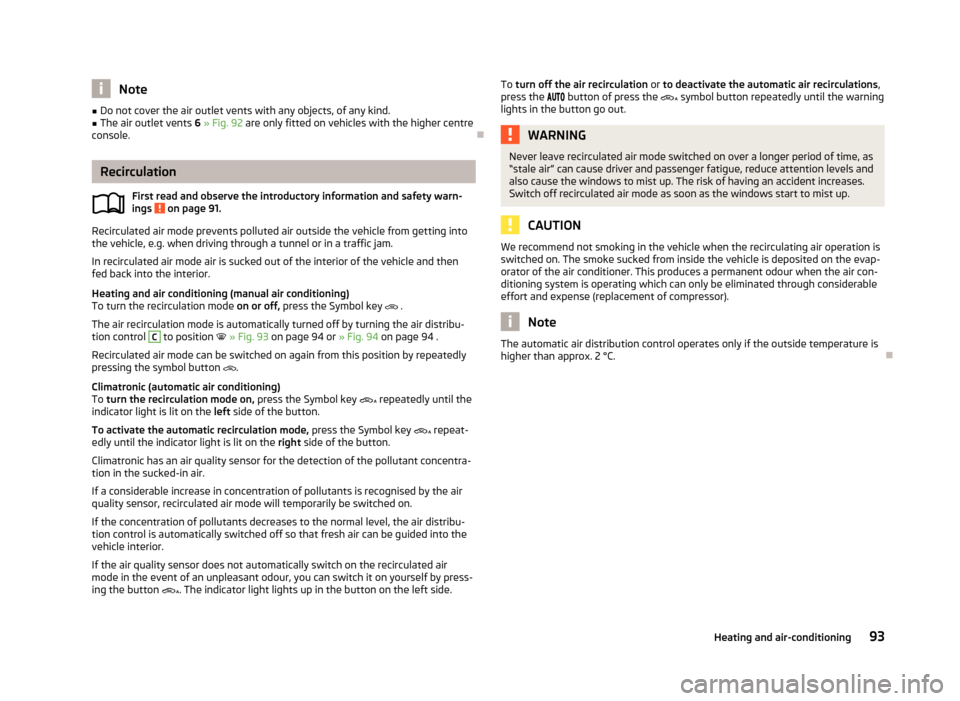
Note■Do not cover the air outlet vents with any objects, of any kind.■The air outlet vents 6 » Fig. 92 are only fitted on vehicles with the higher centre
console.
Recirculation
First read and observe the introductory information and safety warn-ings
on page 91.
Recirculated air mode prevents polluted air outside the vehicle from getting into
the vehicle, e.g. when driving through a tunnel or in a traffic jam.
In recirculated air mode air is sucked out of the interior of the vehicle and thenfed back into the interior.
Heating and air conditioning (manual air conditioning)
To turn the recirculation mode on or off, press the Symbol key
.
The air recirculation mode is automatically turned off by turning the air distribu-
tion control
C
to position
» Fig. 93 on page 94 or » Fig. 94 on page 94 .
Recirculated air mode can be switched on again from this position by repeatedly
pressing the symbol button
.
Climatronic (automatic air conditioning)
To turn the recirculation mode on, press the Symbol key
repeatedly until the
indicator light is lit on the left side of the button.
To activate the automatic recirculation mode, press the Symbol key
repeat-
edly until the indicator light is lit on the right side of the button.
Climatronic has an air quality sensor for the detection of the pollutant concentra-
tion in the sucked-in air.
If a considerable increase in concentration of pollutants is recognised by the air
quality sensor, recirculated air mode will temporarily be switched on.
If the concentration of pollutants decreases to the normal level, the air distribu-tion control is automatically switched off so that fresh air can be guided into the
vehicle interior.
If the air quality sensor does not automatically switch on the recirculated air
mode in the event of an unpleasant odour, you can switch it on yourself by press-
ing the button . The indicator light lights up in the button on the left side.
To
turn off the air recirculation or to deactivate the automatic air recirculations ,
press the button of press the symbol button repeatedly until the warning
lights in the button go out.WARNINGNever leave recirculated air mode switched on over a longer period of time, as
“stale air” can cause driver and passenger fatigue, reduce attention levels and
also cause the windows to mist up. The risk of having an accident increases.
Switch off recirculated air mode as soon as the windows start to mist up.
CAUTION
We recommend not smoking in the vehicle when the recirculating air operation is switched on. The smoke sucked from inside the vehicle is deposited on the evap-orator of the air conditioner. This produces a permanent odour when the air con-
ditioning system is operating which can only be eliminated through considerable effort and expense (replacement of compressor).
Note
The automatic air distribution control operates only if the outside temperature is
higher than approx. 2 °C.
93Heating and air-conditioning
Page 97 of 266
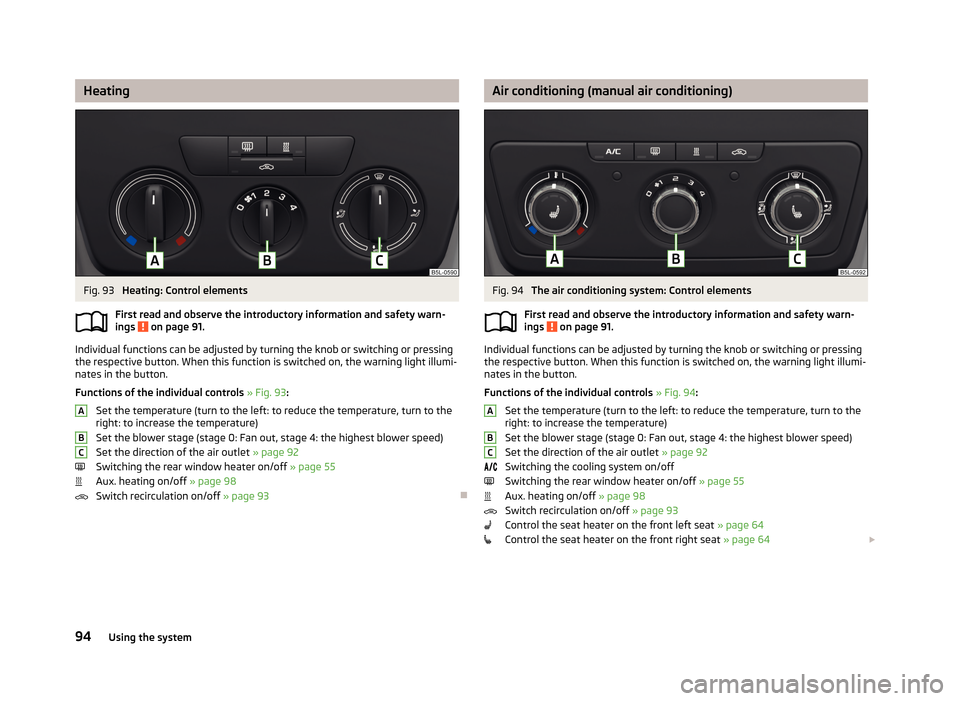
HeatingFig. 93
Heating: Control elements
First read and observe the introductory information and safety warn- ings
on page 91.
Individual functions can be adjusted by turning the knob or switching or pressingthe respective button. When this function is switched on, the warning light illumi-
nates in the button.
Functions of the individual controls » Fig. 93 :
Set the temperature (turn to the left: to reduce the temperature, turn to the
right: to increase the temperature)
Set the blower stage (stage 0: Fan out, stage 4: the highest blower speed) Set the direction of the air outlet » page 92
Switching the rear window heater on/off » page 55
Aux. heating on/off » page 98
Switch recirculation on/off » page 93
ABCAir conditioning (manual air conditioning)Fig. 94
The air conditioning system: Control elements
First read and observe the introductory information and safety warn- ings
on page 91.
Individual functions can be adjusted by turning the knob or switching or pressing the respective button. When this function is switched on, the warning light illumi-
nates in the button.
Functions of the individual controls » Fig. 94 :
Set the temperature (turn to the left: to reduce the temperature, turn to the
right: to increase the temperature)
Set the blower stage (stage 0: Fan out, stage 4: the highest blower speed) Set the direction of the air outlet » page 92
Switching the cooling system on/off Switching the rear window heater on/off » page 55
Aux. heating on/off » page 98
Switch recirculation on/off » page 93
Control the seat heater on the front left seat » page 64
Control the seat heater on the front right seat » page 64
ABC94Using the system